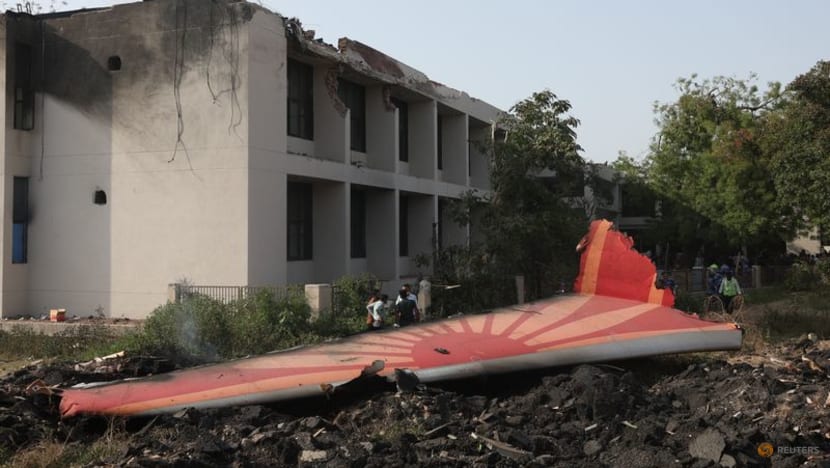Commentary: Tragic Air India crash puts Boeing’s Dreamliner in safety spotlight, again
What caused the Air India flight 171 crash is still unknown, but it has overshadowed Boeing’s hope for a triumphant turnaround, says Endau Analytics’ Shukor Yusof.

Wreckage of a Boeing 787 Dreamliner lies at the site where an Air India plane crashed in Ahmedabad, India, on Jun 12, 2025. (File photo: Reuters/Amit Dave)

This audio is generated by an AI tool.
SINGAPORE: Instead of hobnobbing and securing deals at the Paris Air Show last week, senior Boeing officials were in Gurugram to lend support to Air India following the horrific crash of flight 171 on Jun 12.
Before the tragedy, the American planemaker might have been counting on a triumphant turnaround after the debacle involving the 737 Max. And it had been an unusually busy time for Boeing.
It reported over 300 orders between May and June, fuelled partly by United States President Donald Trump’s state visit to Saudi Arabia, Qatar and the UAE.
Qatar Airways put in an order of up to 210 planes, which included 130 Boeing 787s – the “largest order for 787 Dreamliners” according to the manufacturer. The Doha-based airline also agreed to purchase 30 new 777-9 jets, with options for 50 additional aircraft.
In May, the US Justice Department also dropped its criminal case against Boeing for its role in two fatal 737 Max crashes.
This has now been overshadowed by the disaster in Ahmedabad, where a Boeing 787-8 Dreamliner crashed shortly after take-off, killing at least 270, including all but one of 242 onboard.
A BRIEF HISTORY OF THE DREAMLINER
This is the first fatal accident involving a Dreamliner. What caused it is still unknown, but this uncertainty will no doubt add to Boeing’s woes.
Conceptualised over 20 years ago, the 787 Dreamliner was Boeing’s response to rising jet fuel prices, the market’s desire for a more fuel-efficient jet and an attempt to regain an edge over Airbus.
It was first publicly revealed in January 2003 as the 7E7, with the “E” standing for efficiency, economic and environmental performance. I still have a memento from a visit to Seattle before it became the 787.

A year later, Japan’s All Nippon Airways (ANA) was the first to order 50 jets, with deliveries slated to start in 2008. Delays, however, plagued production (not uncommon for most new types of jet, such as the Airbus A380). The first Dreamliner was delivered in 2011.
The first commercial flight, from Tokyo to Hong Kong, was on Oct 26, 2011. One passenger even paid US$34,000 to secure a seat on the historic flight.
The 787 has now flown for over 14 years, safely transporting over 875 million passengers as of April 2024 according to Boeing. Still, it had its share of concerns and complaints.
One of ANA’s 787 jets suffered electrical system issues in 2013, arising out of the aircraft’s lithium-ion batteries which caused a fire. A Japan Airlines (JAL) 787 also suffered a fire while parked in Boston, prompting the US Federal Aviation Authority (FAA) to order the grounding of the entire Dreamliner fleet.
Boeing also halted Dreamliner deliveries in 2021 due to concerns about production flaws and inspection methods, and again in 2023 for additional fuselage testing. An FAA audit after the January 2024 Alaska Airline’s mid-air blowout found production issues while a separate FAA report raised concerns about Boeing’s safety culture, amid whistleblowers coming forward.
CRITICISMS OF THE 787 UNFAIR, FOR NOW
In light of the Air India crash, more concerns and criticisms of the Dreamliner have appeared. But until we learn conclusively from the official probe, it is best not to speculate and jump to conclusions.
These are harmful and disrespectful to Air India, Boeing and especially to the families and loved ones of those who perished.
Clarification on the AI171’s engine history has nevertheless been critical to quell wild speculation.
The airline’s chairman, N Chandrasekaran, said the aircraft in question had a clean engine history. Air India also said in a statement that one engine was new and the other had been inspected in April.
This is important because there have been several instances of the Dreamliner experiencing engine shutdowns without the pilot initiating them – which had been the matter of many discussions among aircraft engineers, pilots and air safety experts after the crash.
The 787 uses specific engines: the GEnx-1B, made by GE and the Trent 1000, manufactured by Rolls-Royce. Air India’s 787 fleet is powered by the GEnx.
In October 2018, a Scoot 787-9 experienced an uncommanded engine shutdown of its right Trent 1000 engine on descent into Perth Airport, caused by a blocked inlet filter. Two years earlier, a mid-air engine shutdown aboard a Jetstar Airways 787-8 was attributed to an issue within the transfer gearbox of the GEnx-1B engine during a Tokyo-Gold Coast flight.
Virgin Atlantic’s CEO in 2024 criticised Rolls-Royce over the Trent 1000’s durability. “It’s not that it’s not safe, just to be clear,” Shai Weiss stressed, “it’s just the number of cycles you can run a plane with.”
Supply chain challenges are affecting the 787, too, irrespective of the engine type selected by the airline, impacting other carriers like British Airways, Air New Zealand and Kenya Airways.
MAKING FLYING SAFER
Mr Chandrasekaran said that preliminary findings will likely be known in about 30 days. But a final report is likely to take longer as Indian authorities have yet to decide where the jet’s black box recorders should be sent for analysis.
Until then, Boeing will likely have to grapple with travellers questioning the safety of the 787 Dreamliner.
Safety checks by India’s Directorate of Civil Aviation have been completed on 26 out of Air India’s 33 Dreamliners. The FAA has also said it is “too premature” to ground Dreamliners in the United States.
The airline industry, by definition, is very complex. Mechanical and human factors go hand in hand on each of the over 100,000 commercial flights undertaken daily on average, notwithstanding elements beyond our control, such as the weather and medical emergencies.
While many lives were sadly lost in the AI171 tragedy, investigators, manufacturers and operators must ensure they learn more after identifying all factors that contributed to the accident and then implement changes to make flying even safer.
Shukor Yusof is the founder of Endau Analytics, an independent aviation advisory firm based in Singapore.

















